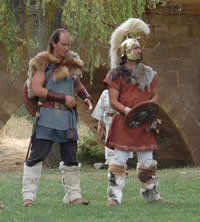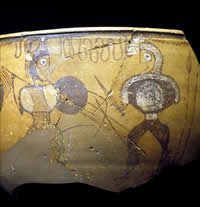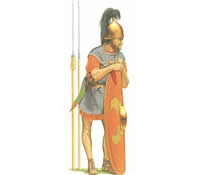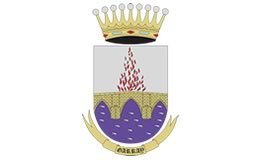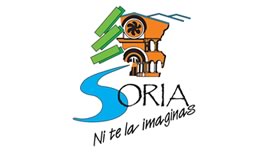

Celtiberians got organized to fight in groups of people on foot and on horseback. The infantrymen had good reputation because they were fast, clever and vigorous. Their military equipment was light: little circular shield or leather caetra; small spear with which they were very skilful; sling and short sword with sharp point and double cutting edge that was used by Romans (“gladius hispaniensis”) and metallic helmet of double crest or leather.
The cavalry was more important than in other towns. Soldiers trained horses through steep slopes and they had to kneel or stop immediately when it was opportune. The cavalry used for horses hard bits found in the Celtiberian necropolis, as well as little spurs in Numantia.
The riders, as the infantrymen, got dressed usually a short tunic, shield put on the right side of the horse breast, leather belt with short sword, one or two spears and, sometimes with helmet of double crest, as on the coins or without anyone as in Numantian ceramics. When it was necessary to help infantrymen they dismounted and acted as them and moreover the rider could be accompanied by an on foot soldier. Only in difficult moments they grouped in column in the shape of a wedge.
Riders and infantrymen went mixed to the war using the tactics that Romans called “concursare” which consisted in rapid changes of attack and flight (war of skirmish) that was put into effect by surprise in territories of short control as ravines, gullies and steep zones. It wandered off the concept of war of the Roman army and it led the historians of the antiquity to talk about indiscipline and groups of bandits.
“Its inhabitants were excellent riders and infantrymen (...) they gave troubles to Romans for their courage”
According to Strabo: “The entire Iberian Peninsula raised...horses mounted in plenty...”,“those of Celtiberia are speckled and painted in different colors and if you move them to Hispania Ulterior they will change color…”, “In agility and skill for the races they were ahead of the remaing towns.”
Silius Italicus refers to the horses raised in Uxama (Osma, Soria): “they are strong for the war in which they withstood long years and with their fighting suffer hardly the bit or they comply with the will of the rider.



